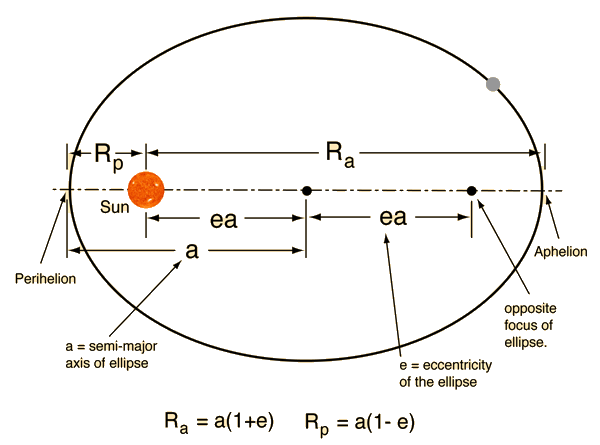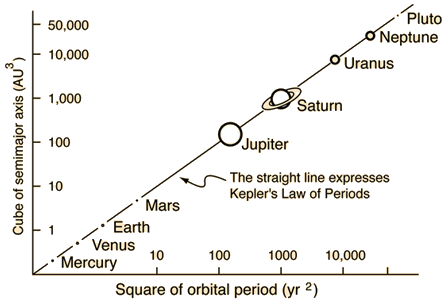NEW
NEW
NEW
KELPER'S LAW
First Law
Kepler was a sophisticated mathematician, and so the advance that he made in the study of the motion of the planets was to introduce a mathematical foundation for the heliocentric model of the solar system. Where Ptolemy and Copernicus relied on assumptions, such as that the circle is a “perfect” shape and all orbits must be circular, Kepler showed that mathematically a circular orbit could not match the data for Mars, but that an elliptical orbit did match the data! We now refer to the following statement as Kepler’s First Law:
The planets orbit the Sun in ellipses with the Sun at one focus (the other focus is empty).
The two thumbtacks in the image represent the two foci of the ellipse, and the string ensures that the sum of the distances from the two foci (the tacks) to the pencil is a constant. Below is another image of an ellipse with the major axis and minor axis defined:
We know that in a circle, all lines that pass through the center (diameters) are exactly equal in length. However, in an ellipse, lines that you draw through the center vary in length. The line that passes from one end to the other and includes both foci is called the major axis, and this is the longest distance between two points on the ellipse. The line that is perpendicular to the major axis at its center is called the minor axis, and it is the shortest distance between two points on the ellipse.
In the image above, the green dots are the foci (equivalent to the tacks in the photo above). The larger the distance between the foci, the larger the eccentricity of the ellipse. In the limiting case where the foci are on top of each other (an eccentricity of 0), the figure is actually a circle. So you can think of a circle as an ellipse of eccentricity 0. Studies have shown that astronomy textbooks introduce a misconception by showing the planets' orbits as highly eccentric in an effort to be sure to drive home the point that they are ellipses and not circles. In reality the orbits of most planets in our Solar System are very close to circular, with eccentricities of near 0 (e.g., the eccentricity of Earth's orbit is 0.0167).
Kepler’s first law has several implications. These are:
-
The distance between a planet and the Sun changes as the planet moves along its orbit.
-
The Sun is offset from the center of the planet’s orbit.
Second Law
In their models of the Solar System, the Greeks held to the Aristotelian belief that objects in the sky moved at a constant speed in circles because that is their “natural motion.” However, Kepler’s second law (sometimes referred to as the Law of Equal Areas), can be used to show that the velocity of a planet changes as it moves along its orbit!
Kepler’s second law is:
The line joining the Sun and a planet sweeps through equal areas in an equal amount of time.
The image below links to an animation that demonstrates that when a planet is near aphelion (the point furthest from the Sun, labeled with a B on the screen grab below) the line drawn between the Sun and the planet traces out a long, skinny sector between points A and B. When the planet is close to perihelion (the point closest to the Sun, labeled with a C on the screen grab below), the line drawn between the Sun and the planet traces out a shorter, fatter sector between points C and D. These slices that alternate gray and blue were drawn in such a way that the area inside each sector is the same. That is, the sector between C and D on the right contains the same amount of area as the sector between A and B on the left.
Since the areas of these two sectors are identical, then Kepler's second law says that the time it takes the planet to travel between A and B and also between C and D must be the same. If you look at the distance along the ellipse between A and B, it is shorter than the distance between C and D. Since velocity is distance divided by time, and since the distance between A and B is shorter than the distance between C and D, when you divide those distances by the same amount of time you find that:
-
A planet is moving faster near perihelion and slower near aphelion.
The orbits of most planets are almost circular, with eccentricities near 0. In this case, the changes in their speed are not too large over the course of their orbit.
For those of you who teach physics, you might note that really, Kepler's second law is just another way of stating that angular momentum is conserved. That is, when the planet is near perihelion, the distance between the Sun and the planet is smaller, so it must increase its tangential velocity to conserve angular momentum, and similarly, when it is near aphelion when their separation is larger, its tangential velocity must decrease so that the total orbital angular momentum is the same as it was at perihelion.
Third Law
Kepler had all of Tycho’s data on the planets, so he was able to determine how long each planet took to complete one orbit around the Sun. This is usually referred to as the period of an orbit. Kepler noted that the closer a planet was to the Sun, the faster it orbited the Sun. He was the first scientist to study the planets from the perspective that the Sun influenced their orbits. That is, unlike Ptolemy and Copernicus, who both assumed that the planet's “natural motion” was to move at constant speeds along circular paths, Kepler believed that the Sun exerted some kind of force on the planets to push them along their orbits, and because of this, the closer they are to the Sun, the faster they should move.
Kepler studied the periods of the planets and their distance from the Sun, and proved the following mathematical relationship, which is Kepler’s Third Law:
-
The square of the period of a planet’s orbit (P) is directly proportional to the cube of the semimajor axis (a) of its elliptical path.
-
P2 ∝ a3
What this means mathematically is that if the square of the period of an object doubles, then the cube of its semimajor axis must also double. The proportionality sign in the above equation means that:
-
P2 = ka3
where k is a constant number. If we divide both sides of the equation by a3, we see that:
-
P2 / a3 = k
This means that for every planet in our solar system, the ratio of their period squared to their semimajor axis cubed is the same constant value, so this means that:
-
(P2 / a3) Earth = (P2 / a3) Mars = (P2 / a3) Jupiter
We know that the period of the Earth is 1 year. At the time of Kepler, they did not know the distances to the planets, but we can just assign the semi-major axis of the Earth to a unit we call the Astronomical Unit (AU). That is, without knowing how big an AU is, we just set a Earth = 1. If you plug 1 year and 1 AU into the equation above, you see that:
-
(P2 / a3) Earth = (P2 / a3) Mars = (P2 / a3) Jupiter
So for every planet, P2 / a3 = 1 if P is expressed in years and a is expressed in AU. So if you want to calculate how far Saturn is from the Sun in AU, all you need to know is its period. For Saturn, this is approximately 29 years. So:
-
(P2 / a3) Saturn = (29 years)2 / (a AU)3 = 1
-
(a AU)3 = 841
-
(a AU) = 3√ 841 = 9.4 AU
So Saturn is 9.4 times further from the Sun than the Earth is from the Sun!




